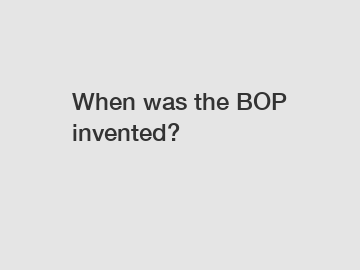When was the BOP invented?
When Was the BOP Invented?
The Blowout Preventer, commonly known as BOP, is a critical piece of equipment used in the oil and gas industry. It plays a crucial role in preventing blowouts and managing well control during drilling operations. But when exactly was this essential device invented? Let's explore the history and evolution of the BOP to better understand its origin and significance.
Early Attempts at Blowout Prevention.

In the early days of drilling, blowouts were a frequent and dangerous occurrence. Engineers and drillers were constantly faced with the challenge of controlling the uncontrolled release of oil and gas from wells under high pressure. The need for a solution led to several attempts at creating devices to prevent blowouts.
The First Successful BOP.
The first successful blowout preventer was developed and patented by James Abercrombie in 1922. Known as the "ram-type" preventer, it used two steel rams to seal off the wellbore. This innovation was a game-changer for the industry, as it provided a reliable method to close off the well in case of a blowout. Abercrombie's invention paved the way for further advancements in blowout prevention technology.
Advancements and Modernization.
Over the years, the BOP underwent significant advancements and modernization to meet the increasing demands and challenges of drilling operations. In the 1940s, hydraulic mechanisms were introduced, allowing for remote operation of the rams. This innovation greatly enhanced the safety and efficiency of blowout prevention.
Deepwater Horizon Incident and Regulation Changes.
One of the most devastating incidents related to blowout preventers occurred in 2010 with the Deepwater Horizon oil spill. The failure of the BOP on the Deepwater Horizon rig led to the largest marine oil spill in history. This incident brought significant attention to the importance of reliable blowout prevention systems and triggered changes in regulations and industry practices.
Following the Deepwater Horizon incident, new standards were established to improve the design, maintenance, and testing of blowout preventers. The United States Bureau of Safety and Environmental Enforcement (BSEE) implemented more stringent regulations and requirements for the industry, aiming to prevent similar incidents from happening in the future.
Conclusion.
The invention and development of the blowout preventer revolutionized the oil and gas industry. From its first successful implementation in the early 1920s to the modern and sophisticated systems used today, BOPs have played a critical role in preventing blowouts and ensuring the safety of drilling operations.
With continuous advancements and improvements, blowout preventers have become more reliable, efficient, and capable of handling the challenges of deepwater drilling. However, incidents like the Deepwater Horizon spill remind us of the importance of constant vigilance, adherence to regulations, and ongoing technological advancements in blowout prevention.
If you have any questions or would like to learn more about blowout preventers and their role in the oil and gas industry, please don't hesitate to contact us.
If you are looking for more details, kindly visit wellhead casing spears machinery exporter, f-1000 mud pump manual, oil country tubing spider.

Comments
0